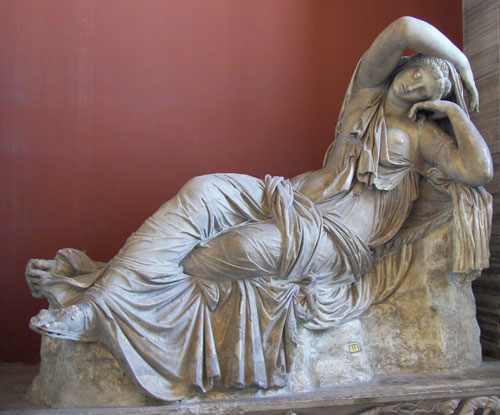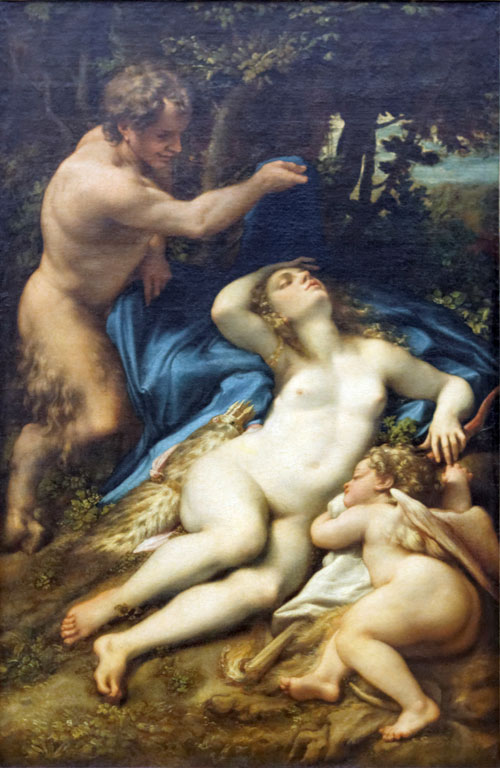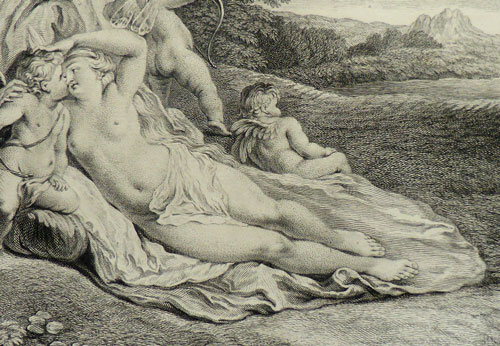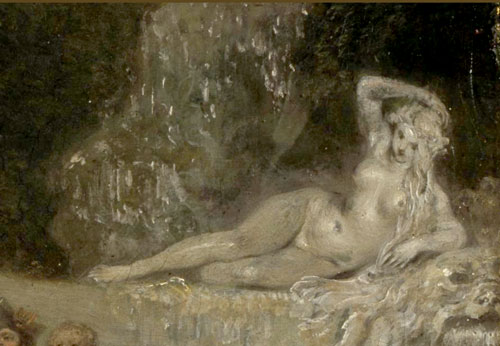
- Home Page
- Accepted
Paintings & Copies - Doubtful
Attributions - Doubtful Textual References
- Alternative
Titles - Collectors &
Museums - Bibliography
- Search Abecedario
- Watteau &
His Circle
X. Jupiter et Antiope
Entered December 2018; revised May 2022
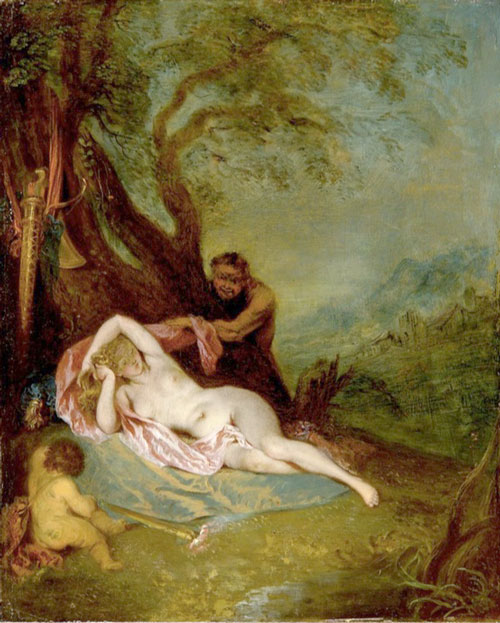
Private collection
Oil on panel
26 x 21 cm
ALTERNATIVE TITLES
Faune et Vénus
Une Femme endormie
Nymphe endormie
Venus and Faun
Vénus endormie, épiée par un satyre
PROVENANCE
Paris, sale, March 20, 1773, lot 19: “Une Femme endormie, qu’un Satyre découvre, un Amour les observe; par Antoine Watteau: hauteur 9 pouces, 8 lignes, largeur 7 pouces 8 lig.” Bought by Vincent Donjeux for 720 livres. [lot 20: “Plusieurs Femmes au bain; par le même: même proportion.”]
Paris, sale, April 15ff, 1782, lot 93, “ANTOINE WATTEAU . . . Deux Tableaux faisant pendant, l’un représente Jupiter & Antiope; l’autre trois femmes au bord de l’eau, qui se déshabillent pour se baigner; leurs fonds sont terminées par un paysage très agréable.” Hauteur 10 pouces, largeur 7 pouces 6 lignes, B.” Sold for 1300 livres to ”Le même” [Guesny, i.e., Robert Quenet] according to an annotated copy of the sale catalogue in the Bibliothèque nationale, Paris.
Paris, collection of Armand Frédéric Ernest Nogaret. His sale, Paris, March 18ff, 1782, lot 93: “Deux Tableaux faisants pendants, l’un représente Jupiter & Antiope; l’autre trois femmes au bord de l’eau, qui se déshabillente pour se baigne; leurs fonds sont terminés par un paysage très agréable. Hauteur 10 pouces, largeur 7 pouces 6 lignes, B.” Sold for 1,300 livres to Robert Quenet according to an annotated copy of the catalogue in the Watson Library, Metropolitan Museum of Art, New York.
Paris, collection of Charles Alexandre de Calonne (1734-1802; statesman). His sale, April 21, 1788, lot 142: “ANTOINE VATTEAU . . . Deux tableaux faisant pendans; l’un représente Jupiter & Antope; l’autre une femme sortant du bain & deux autres femmes qui l’accompagnent. Ces deux Tableaux coloriés comme le Titien, ne laissent rien à desirer tant par leur compositrion agréable que par la touche spirituelle & varié de ce Maître. Hauteur 10 pouces, largeur 7 pouces 6 lignes. B.” Sold for 800 livres to Jean-Baptiste Pierre Lebrun according to an annotated copy of the catalogue in the Bibliothèque nationale.
Paris, collection of Philippe Henri, marquis de Segur (1724-1801). His sale and others, April 9ff, 1793, lot 78: “ANT WATTEAU. Deux Tableaux de la plus admirables couleur & de la touche spirituelle, qui distingue cet Artiste aimable dans son genre; ils représentent de riches paysages. Dans l’un on voit Antiope surprise par Jupiter sous la figure d’un satyre; dans l’autre trois jeunes femmes sortant de se baigner dans un étang, Hauteur 10 p. larg. 7. B.” Sold for 349.19 livres according to an annotated copy of the catalogue in the Rijksbureau voor Kunsthistorische Documentatie.
Paris, collection comte de Solirène. His sale, March 12ff, 1812, lot 128: WATTEAU (Antoine) . . . Peint sur bois, haut. 9½, larg. 7½ p. Jupiter et Antiope, sujet gracieux traité dans un fond de Paysage, terminé par un Lointain de Côteaux et de Montagnes. On y voit à droite cette Nymphe nue et endormie sur une Draperie auprès d’un gros Arbre derrière lequel Jupiter, sous la forme d’un Satyre, soulieve la Draperie qui la couvre. L’Amour vu par le dos est aussi endormi. Son Flambeau, son Carquois et ses Flèches attachés à l’Arbre, forment les accessoires de cette composition agréable, dont la finesse d’exécution répond à la fraicheur du coloris.”
Paris, collection of Joseph-François Xavier, comte de Seneff, de Tournhout et de Pestre (1757-1823; banker). His sale, Paris, April 17-18, 1826, lot 57: “WATTEAU. B. [sic]...Jupiter et Antiope, ou Nymphe dormant et surprise par un satyre. Watteau était éminemment coloriste: on peut en juger d’après ce charmant tableau.”
Paris, sale, March 13ff, 1827, lot 79: “WATTEAU (ANTOINE). . . . Jupiter, Antiope et l’Amour, dans un paysage. Antiope presque nue, dort étendue sur l’herbe: Jupiter, sous la forme d’un Satyre, la contemple avec ardour; et l’Amour, sous la forme d’un faune, paraît endormi auprès d’elle.
Ce tableau, qui est du meilleur temps de ce peintre, provient de la belle collection Solirène. B., H.9 p. 10 l., L. 7 po. 10 l.”Paris, collection of the comte de Lorsindy.
Paris, collection of the marquis de Narbonne-Pelet.
Paris, with Gimpel et Wildenstein; sold to Stanford White.
New York, collection of Stanford White (1853-1906; architect). His sale, New York,”American Art Galleries, November 25-29, 1907, lot 563; “JEAN ANTOINE WATTEAU . . . FAUN ET VÉNUS / Beneath a great tree, upon which hang a bow and quiver, lies the goddess of beauty, asleep, her left arm thrown carelessly above her head, which is supported on her right hand. From behind the tree creeps a swarthy faun, who pulls at the pink velvet robe which forms her only garment. On the ground close by plays a cupid with a torch. The background shows a vista of rocks and hills melting away into the blue of the sky. Height, 11 inches; width, 8 inches. Purchased by MR. WHITE from MESSRS GIMPEL & WILDENSTEIN, Paris.” Bought by William Evans for $550.New York, collection of William Evans.
New York, with Wildenstein and Co.; sold in 1912 to William Salomon.
New York, collection of William Salomon (1852-1919; railroad executive and investment banker). His sale, April 5, 1923, lot 386: “JEAN ANTOINE WATTEAU . . . JUPITER AND ANTIOPE / (Panel) / Height, 10½ inches, width 8¾ inches
ANTIOPE, almost entirely nude and seen at full length as she reclines on green and pink draperies beneath the wide-spreading branches of a tree, is being discovered by the revolting Jupiter. He steadily approaches from behind the tree; in its branches hangs the quiver of Cupid, who is seated in the left foreground and holds a lighted torch in his right hand. Blue sky in the right background.
From the collection of Comte de Lorsindy[sic], and from the collection of the Comte de Narbonne Pelet. Purchased from Gimpel & Wildenstein.
All lovers of the magnificent art of the short-lived Watteau will recall the larger, oval-shaped and different composed painting of the same subject which, after being in the d’Aremberg, Bourlon de Sarty and Patereau Sales, passed into the Louvre. It is there (no. 991) still admired as one of that Museum’s greatest treasures. Yet this were worthy to hang next to it.
This beautiful little picture is a slightly changed version of Watteau’s much larger and famous picture in the Louvre, representing the same subject and reproduced in Edmond Pilon’s “Watteau et son école,” 1912, page 114. The Louvre picture is oval-shaped and shows Antiope sleeping with her left arm hanging down, while in the picture here reproduced it is thrown around her head. As for the Cupid seated on the ground, his quiver and torch, they are omitted in the Louvre picture, for which more probably the one here reproduced was a preliminary study. In both pictures the flesh and coloring are of exquisite beauty. . . .” Bought by William Seaman for Helen Salomon.New York, collection of Helen Forbes Lewis Salomon (d. 1927; widow of William Salomon). Her sale, New York, June 4-7, 1928, lot 767: “JEAN ANTOINE WATTEAU . . . JUPITER AND ANTIOPE / Antiope, almost entirely nude and seen at full length-length as she reclines on green and pink draperies beneath the wide-spreading branches of a tree, is discovered by the revolting Jupiter, who approaches stealthily from behind the trunk; in its branches hangs the quiver of Cupid, who is seated in the left foreground and holds a lighted torch in his right hand. Blue sky in the right background. Panel. Height, 20 ½ inches; width, 8 ¼ inches.
Collection of the Comte de Larsindy / Collection of the Comte de Narbonne Pelet / Purchased from Gimpel and Wildenstein.
This beautiful little picture is a variant of the famous and much larger picture by Watteau in the Louvre [No. 991], one of the greatest treasure of the Museum; it represents the same subject and is reproduced in Edmund Pilon, Watteau et son Ecole, 1912, page 114. The Louvre picture is oval and shows Antiope sleeping with her left arm hanging down, while in the picture here reproduced it is thrown around her head. As for the Cupid seated on the ground, his quiver and torch are omitted in the Louvre picture. In both pictures the flesh and coloring are of exquisite beauty. [See illustration on opposite page]”
Sold for $12,500 to Wildenstein and Co.; purchased January 7, 1928.New York, with Wildenstein & Co. Sold to Baron Heinrich Thyssen-Bornemisza prior to 1930.
Lugano, collection of Baron Heinrich Thyssen-Bornemisza (1875-1974; industrialist).
New York, with Wildenstein & Co. by 1936.
Paris, sale, Hôtel Drouot (Boisgirard & Associés, October 19, 2011, lot 22: “École française du XVIIIe siècle, d’après Jean-Antoine WATTEAU / «Vénus endormie, épiée par un satyre» / Huile sur panneau, parqueté, sans cadre / 26 x 21 cm / 600/800 € / PROVENANCE . . . BIBLIOGRAPHIE . . . EXPOSITIONS . . . .
Paris, collection of Dr. Jean-Yves Rumani.
London, with Christophe Janet.
Private collection.
EXHIBITIONS
Munich, Pinakothek, Sammlung Schloss Rohoncz (1930), cat. 347 (by Watteau, Jupiter und Antiope).
London, Wildenstein Galleries, Watteau and His Contemporaries (1936), cat. 28 (by Watteau, Jupiter and Antiope).
New York, Wildenstein and Co., The Nude in Painting (1950), cat. 13 (by Watteau, Jupiter and Antiope).
SELECT BIBLIOGRAPHY
Lejeune, Guide théorique (1864-65), 1: 215.
Goncourt, Catalogue raisonné (1875), under cat. 42.
Dacier, Vuaflart, and Hérold, Jean de Jullienne et les graveurs (1921-29), 1: 260; 3: under cat. 38.
A. B., “Watteau and His Contemporaries” (1936), 230.
“Notable Works of Art,” (1936), pl. X.
Adhémar, Watteau (1950), under cat. 102.
Mathey, Watteau, peintures réapparues (1959), 35, 67, no. 71.
Macchia and Montagni, L’opera completa di Watteau (1968), cat. 60 -D.
Washington, Paris, Berlin, Watteau 1684-1721 (1984), under cat. P 36.
Bailey, The Loves of the Gods (1992), n. 13.
Craven, Stanford White (2005), 211.
Wintermute, "Surprise! Surprise!" (2012).
Kostyrko, The Journal of a Trans-Atlantic Dealer (2017), 135, 334-35.
REMARKS
Although this painting is generally accepted as representing Jupiter and Antiope, the first known reference to it, namely the 1773 sale catalogue, described it simply as a satyr spying on a sleeping woman. Whether the woman is Antiope, Diana, Venus, or just a sleeping nymph is ultimately of little matter. At some point prior to 1782 the panel was paired with another painting attributed to Watteau, a scene of bathing nymphs, but whether they were seen as Diana’s companions or contemporary French women cannot be determined; in the many auctions where they were paired, there was no mention of a thematic raison d’être. Although the pendants were still together in 1793, they were separated by 1812.
Throughout this period, and almost to the present day, Jupiter et Antiope has been unanimously given to Watteau. Although it was not included in the Jullienne Oeuvre gravé, nonetheless, critics saw evidence of Watteau’s hand. In many of the eighteenth-century sales, the picture was lauded with the phrases habitually used by dealers to promote their stock: “un paysage très agréable,” “colorié comme le Titien,” “touche spirituelle.” Yet the painting is heavy-handed.
The pose of the recumbent Antiope originates in Antiquity, where the most celebrated embodiment is the statue of the Sleeping Ariadne in the Vatican. In the Renaissance, Correggio revived this pose to great effect in his Venus and Cupid Spied Upon by a Satyr and in the following centuries many artist followed his lead, including Watteau. In his Amusements de Cythère, he turned Venus’ upraised arm into a gesture of tender affection toward Cupid. And he restored the pose to its marble origins when he employed it for the fountain figure in his Fêtes venitiennes, although the nymph is very lively and sparkling for a lapidary work. Whereas Watteau’s nudes are graceful, endowed with mellifluous contours, the figure of Antiope in the painting under consideration is graceless, her hipshot pose is exaggerated, her head is disproportionately large and slightly square, and her raised arms create an awkward gesture of sleep. Simply put, she is leaden.
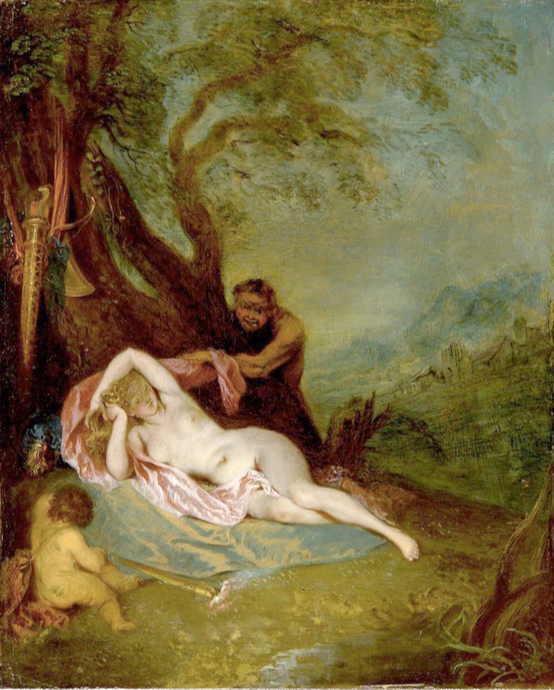
Jean-Baptiste Pater, Jupiter et Antiope.
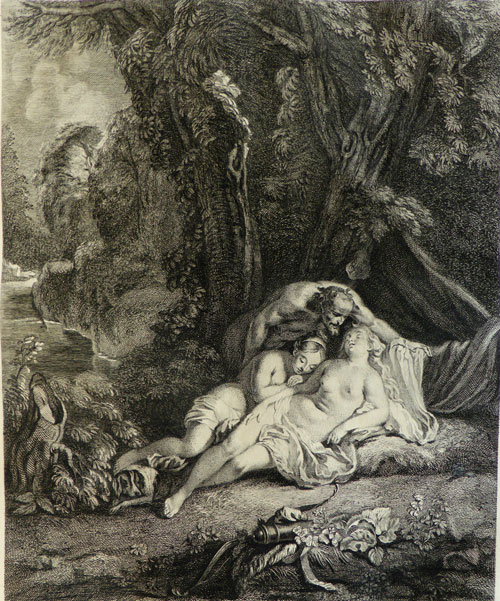
Jean Michel Liotard after Watteau, Le Sommeil dangereux, 1731, engraving.
Jupiter et Antiope has often been associated with a thematically similar Watteau painting, Le Sommeil dangereux. There too a sleeping nude woman is observed and threatened by a satyr spying upon her. This painting, which has not come down to us but is recorded in an engraving in the Jullienne corpus, is an early Watteau composition. Yet, as awkward as his juvenilia may be, it still is more charming and graceful than the Jupiter et Antiope. At least as far back as the time of Edmond de Goncourt, it was suggested that the Jupiter et Antiope was a preliminary sketch for Le Sommeil dangereux, even though Watteau did not make preliminary oil studies for his paintings. Moreover, Jupiter et Antiope’s Venetian-inspired landscape postdates rather than predates Le Sommeil dangereux, making the theory untenable. Nonetheless, the idea that Jupiter et Antiope was a sketch for the other painting was repeated by Dacier, Vuaflart, and Hérold, as well as by Réau,
Over the last half century, critics have dropped the association with Le Sommeil dangereux. Adhémar considered Jupiter et Antopie to be a “variant.” Mathey described the two works as similar composition. Even more important, Macchia and Montagni rejected the attribution of our painting to Watteau. Indeed, as Rosenberg recognized in 1984, “experts have generally rejected” the painting altogether. Bailey accepted the authenticity of the Jupiter et Antiope described in the Nogaret sale, probably not realizing which picture that was. Wintermute alone has fully accepted Jupiter et Antiope as being by Watteau.
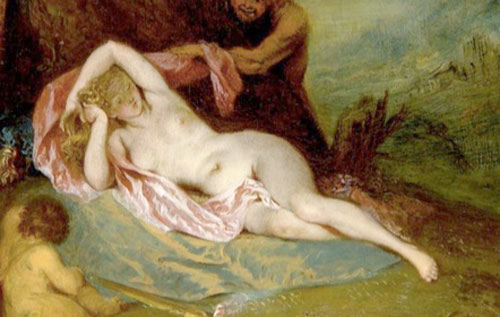
Jean-Baptiste Pater, Jupiter et Antiope.
.-St.-Petersburg,-Hermitage-sampled.jpg)
Jean-Baptiste Pater, La Danse (detail). St. Petersburg, Hermitage
Stylistically, the painting does not resemble Watteau’s established works, but it does resemble Pater’s. It is particularly useful to compare the figure of Antiope with sculpted nymphs on fountains in Pater’s fêtes galantes, especially the nymph in his The Dance in the Hermitage. The statue in the latter painting and the Antiope are like sisters, in pose, corpulence, and the squared shapes of their heads. In addition, the “sketchy,” freely painted quality of Jupiter et Antiope, especially its background, relates much more to Pater than to Watteau.
Apropos of the pendant that was paired with Jupiter et Antiope, we know its dimensions, it was on panel, and it showed three bathing women. Although the eighteenth-century dealers tried to pass it off as a work by Watteau, no such panel by him is known, but there are several paintings of bathing women by Pater. We believe that the two pendants were by Pater and thus there would have been better harmony than if one had actually been by Watteau.
During a 2015 restoration of the painting, the panel was x-rayed and underpainting was revealed. Although it is not entirely decipherable, there is a decorative scheme beneath, one which is particularly visible in the corners and along one of the long sides. An undulant ribbon and some circular disks are all that can be discerned and then only dimly, but they do establish that Pater was re-employing a panel that had been discarded. It is true that Watteau also economized several times: his L’Accord parfait and La Sérénade italien were executed on two halves of a painted carriage door, and his Leçon d’amour was painted over another decorative scheme. But this does not prove that Jupiter et Antiope was his. Rather, it merely demonstrates that the idea of economizing and reusing materials passed from master to pupil.
